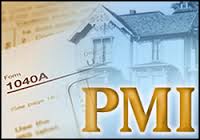What is PMI and how does it work?
 So, you want to own a home but can’t put down a 20 % of the appraised value as down payment? In that case you will have to pay a monthly private mortgage insurance set by your lender. Your lender requires you to pay these monthly premiums to safeguard his interests in case you default and decide later that can no longer make payments on your loan. If this happens, the lender will still get his money through the insurance policy – protecting the lender against the loss.
So, you want to own a home but can’t put down a 20 % of the appraised value as down payment? In that case you will have to pay a monthly private mortgage insurance set by your lender. Your lender requires you to pay these monthly premiums to safeguard his interests in case you default and decide later that can no longer make payments on your loan. If this happens, the lender will still get his money through the insurance policy – protecting the lender against the loss.
You have to pay PMI premiums monthly as they are added to your monthly mortgage payment. Once you have accumulated enough equity in the home, you can request the lender to cancel your PMI. Can you avoid paying PMI? There is only one way to avoid making monthly PMI, i.e., if you have enough to put down 20 percent or more when you are buying a home.
If you look at what benefit it holds for you, getting a mortgage insurance helps you to fulfil your most precious dream of owning a house even when you have not saved up a big amount for the down payment.
Fast Facts on PMI:
- PMI is only applicable to conventional loans, where the condition of paying a minimum of 20 percent down payment is not fulfilled.
- On Federal Housing Administration (FHA) loans, one has to pay an up-front mortgage insurance premium. Want to know if FHA loans are a good choice over conventional loans? Read Things to Know Before Applying for FHA Loan.
- There is no mortgage insurance on Veterans Administration even when they allow 0% down payments. However, VA loans do have an up-front funding fee.
- PMI rate would typically depend on your down payment, term of your loan, credit score and amount of your loan. One must keep in mind that lower down payments will invariable mean high PMIs.
- PMI is basically a percentage of the amount you have borrowed. This means higher the loan amount, more is the PMI.
How can you cancel the PMI?
- According to the Federal Homeowners Protection Act, you have the right to ask your lender to cancel your PMI if you have paid back 80% of the original loan. This means once you have built 20% equity in the property, you can notify your lender to discontinue the PMI premiums. You must notify your lender in writing. If we talk in the language of your Loan-to-Value (LTV) ratio, you usually pay mortgage insurance premiums until your LTV gets to 80 percent. (LTV is the amount of loan divided by the value of your house in the market place). For example, you have bought a home for $500,000 and put down 10 percent, or $50,000, and got a $450,000 loan to pay the rest. Your LTV would be $450,000 divided by $500,000 that equals to 90 percent.
- You can also request your lender to cancel your PMI if your home equity grows to 20 % due to an increase the market price of your home.
- You can also do that if you have made extra payments towards the principal loan.
- As per the Homeowners Protection Act, the lender must automatically cancel your PMI once you have paid 78 % of the mortgage. This means you have accumulated 22 percent equity on the basis of original appraised value of your home. This is applicable even if your home’s market value has dipped. But you must be current on your mortgage.
If you have a clean history of making your monthly mortgage payments on time, have complied with all the terms and conditions of the mortgage, the market value of your home has not dipped, you don’t have other liens such as a second mortgage, and you have notified your lender in writing, your lender should comply with your request to cancel your PMI payments.
To find out about the correct procedures about PMI cancellations, the best route will be to write formally to your lender and request for appropriate guidelines.